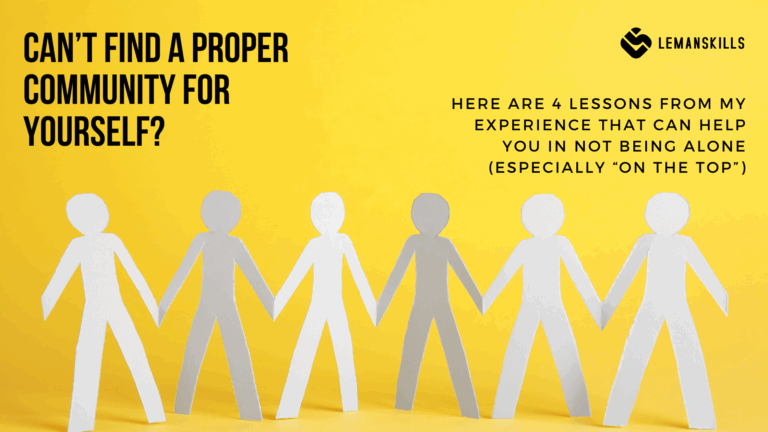We live in a time when we have an infinite access to almost everything with one simple click. Of course it depends where you are on the planet, how much money you have and how strong and stable your internet connection is. But yet, we note one of the highest rates of depression, anxiety and loneliness ever. Why is that happening?
Because it is too much. Our lives are too complex. We have too many roles to play, too many tasks on our task lists (professional and personal ones) to cover. We need to be perfect in every single area of our lives. We want to have everything, so we work 60 hours per week, and then we are so tired that we don’t have strengths to get up from bed on Saturday morning and spend quality time with our families, friends or on our own. We have too many choices to make, and we are tired of making them all the time. It all sounds pretty tiring. So what can we do about it?
We can make it simpler. Simplify our lives and cut most of the complexity of it, so we can focus on what really matters. How? Let’s find out together.
Why we make simple things complicated?
It’s easier to add more things to something, than to simplify it. We have so much information to process in our brains every day, countless tasks, decisions to make, projects to finish. It’s a never-ending story. We make things more complicated because we are afraid of the simplicity. We are scared that simple will be worse, less meaningful, weaker. We say that we are so busy, doing more and more and more to not have to confront ourselves with our real thoughts, emotions, needs. To not need to answer hard questions.
It is really visible when we think about really busy people at work (they say they busy all the time, no matter if it’s true or not). They are at the meetings all the time. Full calendars, week after week. So busy. But, when we ask them a question: “okay, you are busy, but what kind of value do you bring to the table?” it really often appears that those people bring no value. Don’t create anything, any product, innovation, service, process. Just being busy. And the truth is, “busyness” is not a value or a quality, it’s just a mask. To feel protected, important, needed.
The other example can be from home. Let’s say I’m a single mother. I want to be a great mom, employee, friend, daughter, I include myself to organize school picnics, redecorate house. And why I do that to myself when it’s a job for at least 5 people? Because I don’t want to think about my real emotions. That I’m lonely. Exhausted. That I just want one day alone, in silence, with a book and a cup of coffee. Or I just want to prove other people that I can do it all. Prove what? To what people? And why?
That’s what we do as humans – we complicate simple things to not confront with reality, because it’s scary, might be painful, might be hard. Sometimes we complicate things because we don’t have competences, skills to deal with the essence of the real issue. And our ego won’t allow us to say it out loud, because IT’S SO UNPROFESSIONAL to admit that we don’t know something. THAT WE NEED TO BE STRONG. That way we start running on and on in circles, without any chance to stop.
How to change that?
What elements of our lives can be simple again?
To start simplifying our lives, we need to choose what actually we want to change and WHY. What kind of value it will bring? And what to choose to make the best of it? I would say every single element of our live can be simple again, but it might be an exaggeration for some of you. Let’s make a list of examples then.
- Relations. Starting with this one can be tricky, but relations are the most complex thing that we need to face every day. Complex doesn’t mean they should be messy, overcomplicated or hard. What can we do to simplify it? Transparency and clarity of communication. Say what you really mean, don’t expect that the other person WILL GUESS what you really need or mean. We differ from culture to culture, some of us are more direct, some of us are less direct with it, but we all can use more clarity. Set clear boundaries, protect yourself if you don’t want to do something. Always do it with a good intention, don’t hurt other people. Think about the solution, not a problem, where you have an influence, instead of where you have zero of it. Don’t play games, don’t look for guilty. Take ownership of your situation, define what you need and make contracts with others to fulfill that.
- Tasks at work. “I don’t have time for anything, my task list is a never-ending story. I always end my day with something more to do, and it sucks, I feel hopeless”. Sounds familiar? That’s because we do more and more, but we behave like at the very beginning when we have only few tasks to cover. We need better structure to get rid off this feeling that we have always something more to do and we feel guilty of that. Make a list of things that you want to cover today. 1-2 big ones, 3-4 more smaller ones. Not more, if you add more, you won’t have any priorities. Start with the big ones, just get it over with (like Brian Tracy said in his famous book), don’t start with small, less meaningful. Repeat if every day.
- Schedule of a day. It is similar to the previous area, it’s all about structure. When we have structure, we feel safer. When we feel safe, we are more efficient and effective – we do right things, and we do things right. Create a structure of your day that will be repetitive, and thanks to that you won’t need to waste time on unnecessary things, like what to wear or what to eat for breakfast. Remember that each of us has the finite number of optimal decisions we can make every day. Why waste it on something as meaningless as a choice of clothes? Get up every day at approximately the same hour. Have a morning routine. Eat similar breakfast. Have an evening routine. Those things can be really small, but they give you a structure so you can focus on what’s really important.
- Life goals (personal or professional). A lot of us have huge goals. Super ambitious goals. And that’s perfectly fine, we should aim big to win big. But if it’s too big and we don’t know where to start, we quit. We are just like: “naah, it was just a matter of moment, I don’t have capacity/time/money to do it”. That’s why we need to divide bigger goals to smaller ones. To baby steps, achievable ones. It doesn’t mean that we don’t need to stretch in the process, to learn, to do things differently. It just means that we need smaller steps that we cross off the list to feel motivated and keep this energy going to complete the next one. Write down those things you would like to achieve. Then make a list of milestones that you want to achieve all along the way. Then make a plan for the next month. Then for the next week. Make it simpler, you will continue to actually DO things this way, not only talk about them.
- Decision making processes. As mentioned earlier, we have a limited capacity of making good, optimal decisions per day. That’s why we need to make good decisions and reduce decision fatigue. The fatigue is rising when we have more options to choose from. So what you can do is to choose from less to do it faster, be less disappointed by the result and don’t get stuck with choice paralysis. You want to go on a vacation? Create a list of 3 places you want to go and chose only from this list. You don’t know what to wear? Prepare 3 options the night before and decide only between them in the morning. You don’t know what to eat for lunch? Organize your fridge into 3 sections where you will have limited options of products you can use to prepare it. Make it simpler, cut unnecessary decision options. There are here to get us to buy more, while what we need is less.
- Diet. Eating healthy is not hard. When people want to lose weight, they go on a diet and quit it after a couple of weeks (gladly), because it is too complicated. The ingredients are in few different stores, for some of them we need to stay in a line every morning, some are really expensive. So it’s just too much effort, we get overwhelmed, and we quit. Eating well is all about simplicity of products (exclusion of processed products), using seasonal products (i.e. fruits and vegetables), eating elements from each family (good fats, proteins, carbs), so it is well balanced. You don’t need to cook for 3 hours every day to make a lovely meal. You can if you want to, but it is not necessary, and can be really tiring. Prepare a lunch for 3 days. Make similar breakfast every day. Who cares? If it’s tasty, simple and give you energy to kick your day off well, it’s the best choice you can make for your body.
And many more. You can use your own examples that you think are important in your context, individual situation that you are at right now. Make things simple to improve your life, not somebody else’s.
How to create simple without losing value?
As you can see above, simplicity is not a story about losing a value of life. It is about creating different value, focusing energy on right things, instead of doing everything and burn ourselves out on constant want to have more. It is about choosing the right things, that give us the best possible outcome. It’s about being smarter about our time since it’s not infinite.
If you are afraid of losing value when you simplify your life, think if this fear is real. Is it your fear, or is it just a social conviction or a belief that somebody put into our heads years ago? The belief: “I need to be busy to be valuable” is a strong one. But it’s not true. Busyness often is just an excuse to do meaningless things, instead of doing what’s really important. Do what’s important, choose it consciously, don’t let life just to happen to you.
The bottom line
Endless possibilities, endless choices. Wasn’t it what we all always wanted? It appears that it only makes things harder, instead of making it easier. To stop this vicious circle, we need to make better decisions. About what we spend time on, how we structure our day, what we eat, how we build our relationships. We need to spend our time well, doing what serves us, not what hurts us. If you think that’s hard, imagine that yourself on a quiet, sandy beach. You don’t need to do anything. You can choose whatever you want right now. What would you choose?
These are the things that you should start from – if they came to your mind, they are really important. Start from there and keep it simple to get the best from it. It’ll be worth it.




